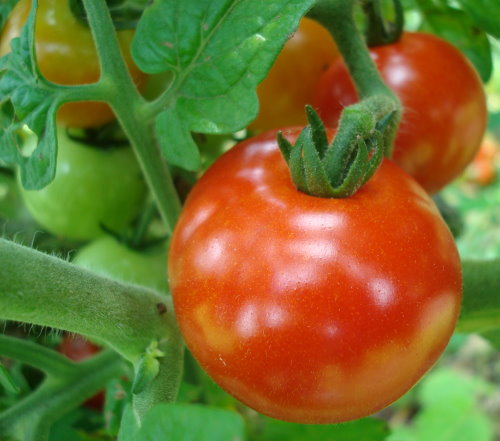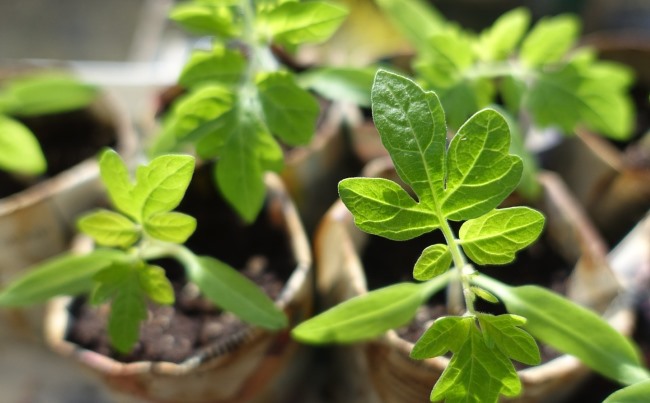Growing Tomatoes Indoors
Growing tomatoes indoors will give you a bumper crop of plump, juicy tomatoes earlier in the season.
Here you'll discover the best varieties, how to grow tomatoes indoors under lights, when to transplant seedlings, when to fertilize and more.

Which Tomato Varieties Grow in Pots?
Look for baby or patio tomatoes in the name to ensure you're getting the small size fruit that grows well in small containers. Grape, cherry and cherry romas produce small fruit.
Good cultivars for growing tomatoes indoors include 'Sweet 100', 'Pixie', 'Tiny Tim' and many others.
Tips for Growing Tomatoes Indoors
How to sow tomato seed: Fill seed trays or small pots with moist, sterilized potting mix. Drop the seeds 1 in (2.5 cm) apart over the soil. Tomato seeds need light and warmth to germinate, so cover the seeds lightly -- never more than 1/4-in (.5 cm) -- with potting medium.
Water and cover. Spray with water until thoroughly moist. Mist as needed to keep the medium moist at all times. After planting and before the seeds sprout, cover the seed trays or pots with clear plastic tray covers or plastic wrap. This will help hold in moisture to prevent the medium from drying out. Seeds will germinate in 5-12 days.
What temperature? Tomatoes love warmth. Depending on your room's temperature, you may want to use a heat mat to help seeds germinate. Average to warm room temperatures (70-80°F/16-27°C during the day, with a 10°F/6°C drop at night), will keep seedlings growing steadily.
 Lots of sunlight is needed to grow tomato plants.
Lots of sunlight is needed to grow tomato plants.How much light is enough? Tomatoes need intense light to grow. If seedlings don't get enough strong light, they'll become spindly. Give them 14-16 hours in front of a sunny window. Turn pots or trays as necessary to prevent seedlings from leaning toward the light.
Don't have a sunny window? Grow lights make good seedlings. Keep the light fixture 4 in (10 cm) above the seedlings -- and leave it on for at least 12 hours a day. Turn it off at night because plants won't thrive in continuous light.
Stake 'em up. It's a good idea to support tomatoes to keep the fruit-laden vines off the soil. Staked tomato plants get better air ventilation and more sunlight. When transferring seedlings to bigger containers, put a tomato cage in each pot at the time of planting. As the plant grows, tie the stem to the support, adding ties as needed to keep stem upright.
These Re-Usable Plant Ties are the easiest I've found to tie tomato stems to stakes, trellises or wire cages. Durable, self-gripping tape is soft, yet strong enough to hold up heavy tomato vines. No more struggling to tie knots in hard-to-reach places.
Keep soil moist. Tomatoes are thirsty, so water as often as needed to keep the soil evenly moist, but not soggy. When growing tomatoes indoors, in a warm, dry house, they may need watered every couple days until they get established. For seedlings, it's best to water from the bottom, using a watering tray. This helps to prevent fungus such as damping off. Use room-temperature water.
Separate seedlings when they grow their "true" (second set of) leaves. Transplant them to 6-in (15 cm) pots, just 1 plant per pot. Plant the stems slightly deeper than they were in the previous pot or tray. Discard any weak seedlings.
When to fertilize. You'll get stronger, healthier growth by giving seedlings a light feeding. Start fertilizing after the first true leaves appear (they are the second pair of leaves that develop). Use a fertilizer solution (fish emulsion or other organic fertilizer) once a week.
Harvesting tomatoes. Check the vines almost daily once tomatoes start ripening. A tomato is ready to pick just a few days after it shows the first sign of red. Harvest fruit at their peak (fully red) to encourage more fruit production. Cut or twist off the tomato, holding the vine at the same time to prevent damaging it.


